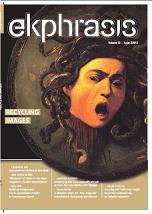“Digitalization” of Art Activism. Case Study of the Cluj-based Collective MindBomb
“Digitalization” of Art Activism. Case Study of the Cluj-based Collective MindBomb
Author(s): Bogdan C. Iacob, Mara RaţiuSubject(s): Theatre, Dance, Performing Arts
Published by: Universitatea Babeş-Bolyai, Facultatea de Teatru si Televiziune
Keywords: art activism / activist art; art activist practices; political activism; digitalization; Internet; social media; contemporary social movements; social change; appropriation; recycling; detournement; cultural jamming
Summary/Abstract: Critical attitudes regarding controversial social contemporary issues could take the form of art activism. The Cluj-based collective MindBomb is a hybrid critical voice, combining political art and activism. Initiated in 2002, following the model of the San Francisco Print Collective, it reunites professionals from creative industries, who refuse to reveal their individual identity. MindBomb has conducted a series of public actions in the city of Cluj-Napoca, and also in various other cities in Romania, on topics such as democratization of the public space, aesthetics of the public space, corruption practices of the political class, as well as ecological matters related to the cyanide extraction of gold in the Apuseni Mountains. If the first series of actions consisted in the production of visually poignant posters illegally scattered all over the city, the last actions took place mostly – and legally – in the digital world, on social networks such as Facebook. The aim of this paper is to analyze the process of ‘digitalization’ of art activist practices of MindBomb, i.e. to investigate the collective’s use of Internet technology and social media in comparison with similar worldwide art activist initiatives and in the broader context of contemporary social movements. It can be asserted that the use of Internet and social media by art activist groups or collectives could be simply understood as means of increasing activist art’s effectiveness in terms of producing social change. However, what we argue is that the improvement of effectiveness – reaching larger and global audiences – generated by the ‘digitalization’ process is not only scope broadening, but it has an impact on the very nature of art activism. Subsequently, along with analyzing the types of images MindBomb creates – via appropriation, recycling, detournement or cultural jamming –, we examine the thin line between art activism and political activism.
Journal: Ekphrasis. Images, Cinema, Theory, Media
- Issue Year: 10/2013
- Issue No: 2
- Page Range: 197-211
- Page Count: 15
- Language: English

